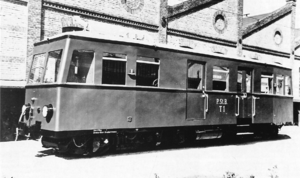PStB T1
| PStB T1 | |
|---|---|
|
PStB T1
|
|
| Numbering: | PStB T1 |
| Number: | 1 |
| Manufacturer: |
Waggonfabrik Fuchs BBC |
| Year of construction (s): | 1941 |
| Retirement: | 1965 |
| Axis formula : | Bo'2 ' |
| Genre : | CPw4Tde |
| Gauge : | 1000 mm ( meter gauge ) |
| Length over buffers: | 11,100 mm |
| Length: | 10,160 mm |
| Height: | 3,500 mm |
| Width: | 2,520 mm |
| Trunnion Distance: | 6,400 mm |
| Bogie axle base: | 1,500 mm |
| Total wheelbase: | 8,000 mm |
| Service mass: | 24.5 t |
| Friction mass: | 24.5 t |
| Wheel set mass : | 6.2 t |
| Top speed: | 25 km / h constructively 50 km / h |
| Installed capacity: | originally 162 kW (220 PS) after conversion 110.4 kW (150 PS) |
| Wheel diameter: | 800 mm |
| Motor type: | Originally MAN W6V after conversion KHD A8 L 614 |
| Motor type: | Originally six-cylinder four-stroke diesel engine after conversion of eight-cylinder four-stroke diesel engine with air cooling |
| Power transmission: | diesel-electric |
| Brake: | Air brake , hand brake |
| Seats: | 26th |
| Classes : | 3. |
The PStB T1 railcar was a four-axle diesel railcar of the Plettenberg Tram , which was built in 1941 by the wagon factory Fuchs and Brown, Boveri & Cie. was built as a tow car and was in use until 1960. In 1968 it was scrapped at the Sylter Inselbahn .
History and commitment
After efforts to electrify the Plettenberg tram failed in 1927/28, the company wanted to modernize operations with a diesel-electric multiple unit in the second half of the 1930s, and in 1938 ordered the later T1. The mechanical equipment was initially to be manufactured by MAN , but due to the war economy , it was carried out by the Fuchs wagon factory . The outbreak of war delayed the production of the vehicle, so that it was only delivered in December 1941.
The car was approved for a maximum speed of 50 km / h, which it could not drive on the Plettenberg tram. After the introduction of the air brake , 25 km / h were permitted on the company's own track and 8 to 12 km / h on roads. The consequence was constant problems with the oil cooling and visits to the workshop, including a piston seizure . It was not until 1954/55 that it was equipped with an air-cooled engine from KHD that helped.
The railcar could carry up to four passenger cars on the steeply steep Oestertal Railway . In freight transport, he carried trolleys .
The abandonment of passenger transport made the railcar superfluous in 1958. In 1960 it was sold to the Sylter Inselbahn and was to be named T65 there . Due to the complicated technology and sensitive electrical circuit, only test drives were carried out there. It was retired in 1965 and scrapped in 1968.
Constructive features
The box frame of the car body was made of lightweight frame construction and consisted of electrically welded structural steel profiles. One door to the passenger compartment was designed as a double sliding door and provided access to the passenger compartment via two steps. A slightly higher sliding door provided access to the luggage compartment. The interior consisted roughly in equal parts of the passenger compartment with 26 seats in the 3rd car class and the luggage or engine compartment. The machinery took up about a third of the interior. The driver's cabs could be reached through the passenger or luggage compartment.
The machinery originally consisted of a six-cylinder four-stroke diesel engine of the type MAN W6V, which was connected to a main generator from Brown, Boveri & Cie. with an output of 100 kW was directly connected. An auxiliary generator with an output of 3.4 kW was also driven. In each of the bogies , two electric traction motors with an output of 59 kW were installed, which were designed in a dead-bearing design . The engine system was changed in 1954/55 by replacing the diesel engine with an air-cooled type KHD A8 L 614 , which eliminated the problems with overheating when driving slowly.
With the purchase of the railcar, the compressed air brake was introduced on the Plettenberg tram. As a result, the passenger trains were equipped with this braking system, the freight trains were never equipped with a braking system. The railcar was equipped with a coal heater. A special feature were the two direction indicators on each side, analogous to the trams of the time, as the Plettenberg tram mostly operated in the street position . Originally the car had a dark green box, the frame was painted black and the roof was beige, from 1955 it was painted red and ivory.
literature
- Wolf Dietrich Groote: The Plettenberger Kleinbahn . Verlag Kenning, Nordhorn 2002, ISBN 3-933613-56-6 , p. 72-73 .
Web links
- Photo of the PStB T1 at the Sylter Inselbahn on eisenbahnstiftung.de
- Website of the Plettenberger Kleinbahn with a mention of the car
- Website with a photo of the PStB T1
Individual evidence
- ↑ Wolf Dietrich Groote: The Plettenberger Kleinbahn . Verlag Kenning, Nordhorn 2002, ISBN 3-933613-56-6 , p. 72-73 .
- ↑ Wolf Dietrich Groote: The Plettenberger Kleinbahn . Verlag Kenning, Nordhorn 2002, ISBN 3-933613-56-6 , p. 11 .
